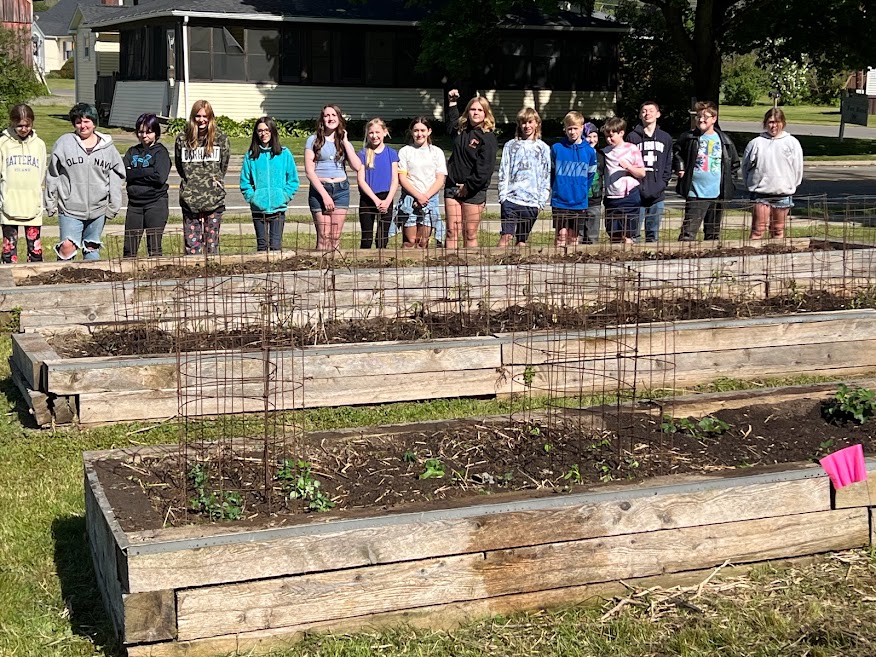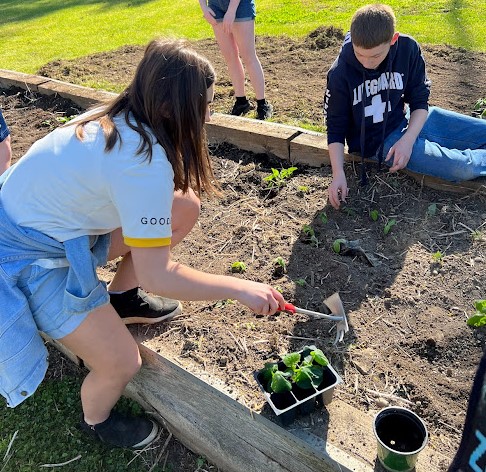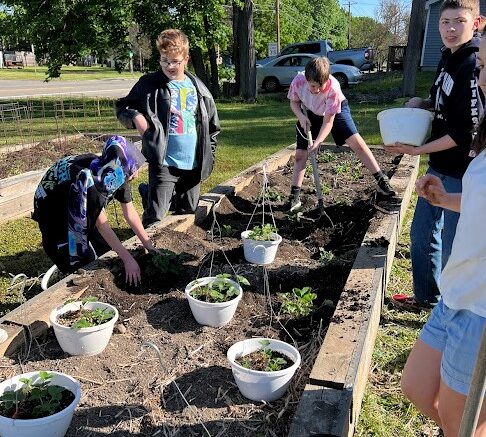In Newark Valley, an annual gardening project completed by middle and high school students and their teacher at the end of May is starting to bear the fruits of their labor.
On the menu this season are potatoes, tomatoes, cucumbers, peas, pumpkins, and squash; and, in addition, this year’s crew, led by Science and Agriculture teacher and FFA Advisor Greg Schweiger, shared, “We experimented with strawberries.”
Located within the Village of Newark Valley, the original community garden, and fashioned with three elevated beds, was built in the fall of 2018 with the help of several volunteers. A joint venture with the Village, the Owego Rotary assisted with a grant for the project, and the first crops were planted in the spring of 2019.

Middle school students in Newark Valley pose in front of elevated beds at the community garden in the Village. The students took part in planting crops at the end of May, and have since started to see the fruits of their labor. The community garden has also sparked renewed interest in the school’s FFA programs. Provided photo.
Newark Valley Village Trustee Ted Hardenstine remarked, “The community garden has been a nice addition to our village. Greg and the school district have done a terrific job working with the community, and we look forward to collaborating on future projects as well.”
Schweiger wears many hats, and even during the summer months as basketball coach and a leader at a summer basketball camp, as well as the instructor at a summer environmental science camp. He also manages to dig up some time for the upkeep of the community garden, along with help from a few students.
The planting process began in the spring when Schweiger’s high school students took on planting some seeds, and then in late May the middle school students stepped in to physically plant the seedlings and other plants at the community garden.
Schweiger remarked, “We plant crops that are good choices for a fall harvest,” and then once students return to school in the fall they will roll up their sleeves to help harvest the crops.
“Potatoes, and this year red and white potatoes, are an example of a good fall harvest choice,” Schweiger said. Once harvested, the food is donated to the nearby food pantry at the Methodist Church, with some set aside for a “share table” in the Village. A small batch is saved for classroom projects that evolve around food science and then, depending on the yield, some items are extended to the school cafeteria where students enjoy eating from the harvest.

Newark Valley students are seen planting crops at the community garden in the Village in late May. In the fall, students will harvest the crops. Some crops are used to make other foods in the classroom, or extended to the school cafeteria. Provided photo.
“We donate as much as we can,” Schweiger remarked, and further explained that students also get the chance to be chefs in the kitchen, too; for example, “Making tomato sauce or salsa with our cherry and Roma tomatoes.”
The strawberry experiment this year, Schweiger commented, yielded only about a pint or two, and that is typical for a first season. If the pumpkin harvest is a winner this year, Schweiger foresees using them for classroom learning opportunities, or to decorate school classrooms.
Every student at Newark Valley passes through Mr. Schweiger’s classroom, and since sixth and seventh graders are required to take a ten-week “Intro to Ag” class. He will see some of those students again in future classes, such as in his biology class, or animal or environmental science courses at the high school.
Schweiger, self-described as a “late-in-life” teacher, and who earned his college degrees following 20 years as a dairy farmer, is pleased that the FFA program has expanded.
Newark Valley was the first in the county to re-launch the program with a chapter chartered in 2017 and, more recently, a chapter was started for students in the sixth and seventh grades.
The interest and enthusiasm, Schweiger noted, has grown tremendously, with about 20 active students in the high school FFA, and upwards of 15 in the middle school.
Schweiger has seen other positive results from that enthusiasm. Two of his students, one who was an FFA President and graduated from Cornell University, and another who has embarked on a career at a veterinary clinic, are just two examples.
FFA students from all around the county will take part at the upcoming Tioga County Fair in August, and will also volunteer their time at “Sundaes at the Farm,” being held this Sunday, July 16, at Engelbert Farms in Nichols.
Whether it’s scooping ice cream, helping to park cars or showing off their knowledge, Schweiger said, “More interest has been generated from our involvement with area events.”
Planting those initial seeds, it appears, has sowed a win-win for all involved.



Be the first to comment on "The fruits of their labor"